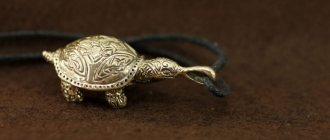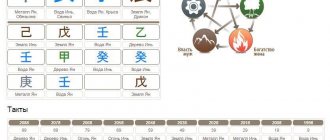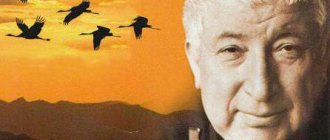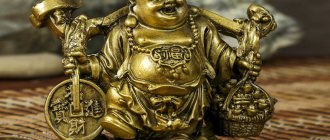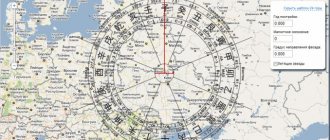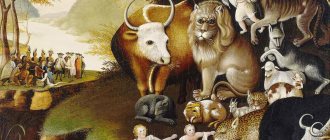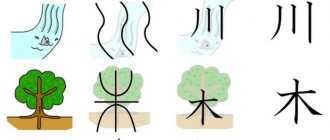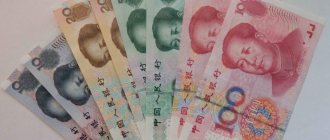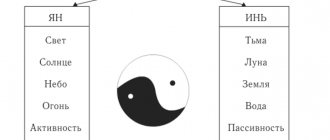Heaven (天 tian) is one of the fundamental categories of Chinese culture. China is often called the Celestial Empire. The Chinese emperor bore the title "Son of Heaven." It was believed that Heaven was giving him a Heavenly mandate to rule. Only the emperor had the right to make sacrifices to Heaven and was responsible before Heaven for the well-being of the people.
Round altar in the Temple of Heaven in Beijing. During the Ming and Qing eras, on the day of the winter solstice, the emperor performed a sacrifice ceremony here in front of the sacred tablet of Heaven.
一 (yī)
Translation : one
Just a horizontal line. Easy to remember, isn't it? The most interesting thing is that two in Chinese are two horizontal lines:
二(èr) - two.
And three... guess what! Three features!
三(sān) - three.
Then it’s more complicated, so for now we’ll focus on the first three numbers.
Examples of use:
我一个人来。 (wǒ yī gè rén lái) - I came here alone.
我要一个。 (wǒ yào yī gè) - I would like one (when buying or ordering something).
Chinese mountain names
The hieroglyph 山 shan, meaning “mountain,” is very common in the names of Chinese mountains. Depending on the context, this hieroglyph may or may not be translated. In addition, there may be characters 峰 feng - “peak”, 岭 ling - “ridge”.
Tianshan 天山- “heavenly mountains”, “divine mountains”, which are located in Central Asia in the territory of Kyrgyzstan, Kazakhstan, China (Xinjiang Uyghur Autonomous Region), Tajikistan and Uzbekistan. According to one version, this name is a tracing of the Turkic Tenir-Nishan (God + mark).
Nanshan 南山- "southern mountains", located on the northeastern outskirts of Kunlun.
Beishan 北山- “northern mountains”, are located in Gansu province between Lake Lop Nor in the west and the Ruoshui River (Edzin Gol) in the east.
In Taoism, the “five great mountains”五岳 wu-yue are revered, associated with the concept of the “five elements” 五行 wu-xing:
Taishan 泰山(Shandong Province), literally “huge mountain”, “serene mountain”, symbolizes the East and is the most revered among the five peaks. In Chinese mythology, it is considered the habitat of Taoist saints and immortals. The Han Emperor Wu Di (156-87 BC) repeatedly made sacrifices on the top of Taishan. On the slopes of Taishan there are 22 temples, 97 ruins, 819 stone slabs, 1018 rock paintings and inscriptions. There are 7,200 stone steps leading to its top.
Huashan 华山(Shaanxi Province) - “blooming mountain”, “patterned mountain”. It symbolizes the West and is famous for its picturesque cliffs and dangerous climb to the top.
Hengshan 衡山(Hunan Province). Its name can be translated as “mountain of balance.” On its slopes there are numerous Taoist temples and Buddhist monasteries. She symbolizes the South.
Hengshan 恒山(Shanxi Province). The character 恒 hen (gen) is translated as “long”, “constant”. Hengshan is famous for the “hanging” temple complex of Xuankun-si 悬空寺, which was built in 491, during the Northern Wei era. This is the only temple in China that combines three teachings: Confucianism, Taoism and Buddhism. Hengshan symbolizes the North.
Songshan 嵩山(Henan Province) is the “highest mountain” symbolizing the Center. Near it are the archaeological zone of Erlitou and the “capital of the nine dynasties”, the city of Luoyang. There are numerous historical monuments here, including the famous Buddhist Shaolin Monastery 少林寺.
four sacred mountains revered in Chinese Buddhism :
Wutaishan 五台山(Shanxi Province). Its name can be translated as “Mountain of Five Heights”: there are five peaks here: Northern, Western, Southern, Eastern and Central. It is considered the habitat of the Bodhisattva of Wisdom Manjushri (Chinese: Wenshu 文殊).
Emeishan 峨嵋山(Sichuan Province) is considered the eternal residence of the Bodhisattva Dharma Samantabhadra (Chinese Puxian-pusa 普贤菩萨).
Jiuhuashan 九华山(Anhui Province). Its name can be translated as “Mountains of Nine Beauties”. In the past, the mountain was called differently - Lingyanshan 陵阳山, as well as Jiuzishan 九子山. According to legend, the famous Tang poet Li Bo (701-762/763) visited these places, saying: “The Hidden has two types*, with Nine beauties open in Lingshan.” This is how this mountain got its current name.
*reference to the first Zhang of the Tao Te Ching
Putuoshan 普陀山(Zhejiang Province, Putuoshan Island) is considered the place of enlightenment (Skt. Bodhimaṇḍa) of the Bodhisattva of Compassion Avalokitesvara - the goddess of mercy Guanyin 观音.
十 (shi)
Translation : ten
Another numeral that is easy to remember.
十诫 (shí jiè)一 10 commandments.
Examples of forming numbers with 十:
十一 (shí yī) - eleven;
十二 (shí èr) - twelve,二十 (èr shí) - twenty (two tens);
十三 (shí sān) - thirteen,三十 (sān shí) - thirty (three tens).
In other combinations, the word can be translated differently:
十分 (shí fēn) - very much;
十成 (shí chéng) - completely.
人 (rén)
Translation : man
Looks like a cartoon man, doesn't it? More precisely, on his feet, confidently walking somewhere. Stick, stick...
The funny thing is that if you add one more person, the meaning will change to “everyone”, “everyone”:
人人都爱喝可乐。 (rén rén dōu ài hē kě lè) - Everyone loves soda.
Moreover, “man” in Chinese is 男人(nánrén) , and woman is 女人(nǚrén) .
Other usage examples:
人丛(rén cóng) - crowd of people;
人体(rén tǐ) - human body;
He is a very popular guy (person) .
女人一般比男人长寿。 (Nǚrén yībān bǐ nánrén chángshòu.) - Women usually live longer than men.
Temples and monasteries, palaces and parks
As a rule, these names, being proper names, are not translated into Russian. However, in some cases, you can lose the deep meaning inherent in them.
For example, in the vicinity of Hangzhou there is the famous Buddhist monastery of Lingyin-si灵隐寺, on the territory of which there is the famous rock Feilai-feng飞来峰. I think these names left a lot of questions. The name of the monastery is translated as “Temple of the Refuge of the Soul”, and the rocks are translated as “Flying Rock”. There is at least some clarity now. And, as is usual with the Chinese, for each such case there is its own legend (or more than one) that explains these names.
Another attraction of these places is the Longjing tea , translated as “dragon well”. Surely you were more “hooked” by the Russian translation than by the Chinese name. Although it did not bring much clarity, it certainly aroused interest.
上 (shang)
Translation : up, above, at the top; on
The symbol seems to be moving upward - this is a hint that makes it easier to remember.
水果在桌子上。 - The apple (is) on the table.
请上楼。—Please go up the stairs.
他上电台了。 (Tā shàng diàntáile.) - He is on the radio.
晚上 (wǎn shàng) - in the evening.
早上 (zǎo shàng) - in the morning.
上车 (shàng chē) - to get into the car.
It is also often used when we talk about “visiting something” or “going somewhere”:
上课 (shàng kè) - to go to classes;
上班 (shàng bān) - to go to work.
Chinese names of rivers and lakes
River names often contain the characters 河 he, 江 jiang or 水 shui (water). The character 江 jiang means big river. Lakes are designated by the characters 湖 hu and 池 chi (pond), large lakes and seas - 海 hai (sea).
Yellow River 黄河, lit. "Yellow River". The color of its water actually has a yellowish tint due to the large amount of loess it contains. The banks along the middle and lower reaches of the Yellow River are considered the cradle of Chinese civilization.
Huaihe 淮河carries in its waters a large amount of suspended matter, which it deposits on the bottom, raising it above the level of the plain, causing floods that are catastrophic in their consequences. As a result, the river repeatedly changed its course, flowing either into the Yangtze, then into the Yellow River, or into the Yellow Sea. Perhaps this can partly explain the hieroglyph 淮 huai in its name, which translates as “to pour in”, “merge”, “to fall”.
The Yangtze in China is usually called Changjiang 长江, literally “long river”. It is the largest river in China and the third largest and longest river in the world. In the lower reaches it was called Yangtzejiang 扬子江. The character 扬 means “to rise”, “to rise”; Like other rivers in China, the Yangtze River carries a lot of suspended matter in its waters, which raised its bed above the surrounding plain and forced it to change it repeatedly. It was this name that entered the European and Russian languages.
Amur in Chinese is called Heilongjiang 黑龙江, literally “Black Dragon River”. According to the Wu Xing system, black is considered an attribute of the north and was associated, among other things, with wisdom. Since ancient times, rivers have been considered one of the habitats of the dragon. In addition, dragons were revered as creatures that protect China and Chinese civilization. So the wise black dragon that lives in northern China is quite good protection. The Manchu name for this river is Sahaliyan ula, the Mongolian name is Qaramörin, which means “Black River”.
Zhujiang 珠江means "pearl river". This is the third longest river in China after the Yangtze and Yellow River, and the second in terms of depth after the Yangtze. Zhujiang is formed at the confluence of the Xijiang 西江 ("West River"), Dongjiang 东江 ("East River"), and Beijiang 北江 ("North River") rivers. In the past, the name Zhujiang only referred to the navigable branch of the Xijiang River Delta 西江. The Pearl River owes its name to the pearl industry: since ancient times, pearls have been grown here in special creeks in a subtropical climate. In addition, there is a picturesque single rock with a round shape and a smooth surface on the river. On moonlit nights it resembled a huge pearl. According to legend, this is what prompted local residents to grow pearls.
The Xiangjiang 湘江is the largest river in Hunan Province and the largest tributary of the Yangtze. Flows into Lake Dongting. According to legend, the “Xiang consorts,” two daughters of Emperor Yao and the wives of Emperor Shun, Ehuan 娥皇 and Nüying 女英, committed suicide in the Xiangjiang River, unable to bear the death of their husband. Along the banks grows spotted bamboo Xiangfei 湘妃竹 (“Xiang consorts”); According to legend, the stains on it are the tears of the yearning wives of Emperor Shun.
Dongting Lake 洞庭湖is located in the northeastern part of Hunan Province and is a large shallow flood lake in the Yangtze Basin. Dongting 洞庭 translates as “cave hall”: according to legend, under the lake there is a huge cave in which the spirits of Shun’s wives, Ehuang and Nyuying, live. It is believed that underground passages extend from this grotto to all parts of China. Lake Dongting is famous for its dragon boat races, which are held in memory of the poet Qu Yuan (340-278 BC), who committed suicide. In the center of the lake is the island of Junshan 君山, which was once a place of retreat for Taoists.
Wu Zhen (1287-1354). Hermit fisherman on Dongting Lake
Lake Qinghai青海湖 is the largest lake in China and the second largest closed lake in Central Asia after Issyk-Kul. Its name translates as “blue sea” or “green sea”. In Mongolian it is called Khukh-Nur or Khokh Nuur, which means “blue lake”. Therefore, it is also called Kukunoor. In 1892, Lake Kukunor was explored by N.M. Przhevalsky.
♦ On the topic: Rivers of China, Lakes of China
下 (xià)
Translation : down, below, under
And this symbol, on the contrary, seems to be directed downward. And it has exactly the opposite meaning to the previous one.
小猫在桌子下面。— The kitten (is) under the table.
今天下雨了。— It’s raining today.
In addition, it is also used in the meaning of “to leave”, “to leave”, “to go out”, etc.:
下班 (xià bān) - to leave work;
下课 (xià kè) - to leave class;
下车 (xià chē) - to get out of the car.
Common characters in Chinese place names
The following characters are often used in the formation of Chinese place names:
- related to cardinal directions and orientation in space:
- 北 bei "north": Beijing (Beijing) 北京, Beishan 北山
- 东 dong "east": Shandong 山东, Donghuan 东皇
- 南 nan "south": Nanjing 南京, Nanchang 南昌
- 西 si "west": Xining 西宁, Guangxi 广西, Xi'an 西安
- 中 zhong "center": Zhongguo (China) 中国, Zhonghai 中海
- 上 shang "at the top": Shanghai 上海, Shangqing 上清
- 下 xia "below": Tianxia (Celestial Empire) 天下
- describing the world around us:
- 口 kou "mouth", "mouth", "hole": Haikou 海口, Zhangjiakou 张家口
- 龙 long "dragon": Longhai 龙海
- 头 tou "head": Baotou 包头, Shantou 汕头
- 天 tian "sky": Tianjin 天津
- 峰 feng "peak": Ruzhongfeng 祝融峰
- 海 hai "sea", "big lake": Haikou 海口, Shanghai 上海
- 河 he "river": Yellow River 黄河, Hebei 河北
- 州 zhou "land", "region": Lanzhou 兰州, Suzhou 苏州
- 江 jiang "big river": Lijiang 丽江, Jiangxi 江西
- 长 chang "long": Changchun 长春, Changsha 长沙
- 池 chi "lake", "pond": Dianchi 滇池
- 城 cheng "city wall": Qingchen 青城
- 山 shan "mountain": Shanxi 山西, Shandong 山东
- 石 shi "stone": Shilin (stone forest) 石林
- 阳 yang "sun": Luoyang 洛阳, Yangshuo 阳朔
- palaces, temples, monasteries:
- 宫 gong "palace", "residence": Gugong 故宫, Shangqinggong 上清官
- 庙 miao “monastery”, “shrine”: Nanyue Damiao (Great Temple of the Southern Peak) 南岳大庙
- 寺 si "monastery": Lingyin-si 灵隐寺, Shaolin-si 少林寺
- 坛 tan "altar": Tiantan (Temple of Heaven) 天坛, Zhitian (Altar of the Sun) 日坛
- 园 yuan "park": Yiheyuan 颐和园, Yuanmingyuan 圆明园
- expressing peace and tranquility:
- 安 an "peace", "harmony": Xi'an 西安, Anhui 安徽
- 宁 ning “quiet”, “calm”, “peaceful”: Yinging 伊宁, Nanning 南宁, Liaoning 辽宁
- names of kingdoms and dynasties:
- 汉 han "Han", "Chinese": Wuhan 武汉, Hanshui 汉水
- 秦 qin "Qin": Qinhuangdao 秦皇島
- 国guo “kingdom”, “principality”: in the names of ancient kingdoms and principalities: Chu-guo (Kingdom of Chu) 楚国, Lu-guo (Kingdom of Lu) 鲁国
Of course, this is not an exhaustive list.
Map from Shanhaijing (“Catalogue of Mountains and Seas”)
日 (rì)
Translation : day, sun
Short for 日本 (Japan). The main meaning is day, daytime. If you add one more character, you get the meaning “every day”. In addition, this symbol is used when writing dates. That is, 5日, for example, will mean the fifth day of a month. Example:
2019年4月1日—April 1, 2021.
More examples of using the symbol:
每日 - every day, every day;
昨日 - yesterday;
日出 (rì chū) - sunrise.
月 (yuè)
Translation : month, moon
In Chinese, months do not have their own name - each month consists of a numeral and the symbol 月: 1 month, 2 month, etc.
一月 (Yī yuè) - January;
二月 (èr yuè) - February;
三月 (sān yuè) - March.
Instead of symbols, by the way, there may be the usual Arabic numbers (1月, 2月, 3月). Therefore, the names of the months in Chinese are easy to remember. By the way. We have already written about this.
Son of Heaven (tianzi)
In Chinese culture, Heaven was seen as the source of imperial power. Until 1912, the rulers of China bore the title "Son of Heaven" (Tianzi 天子). The emperor was believed to support the interaction between the three members of the Great Triad - Heaven, Earth and people, which is reflected in the character wang 王 - ruler. As the high priest, only he could make sacrifices to Heaven and Earth. His sacrifices to the spirits of the earth and grain ensured the prosperity of the entire Celestial Empire. The emperor also exemplified filial piety by making sacrifices at the Ancestral Temple.
The life of the emperor as the Son of Heaven was clearly regulated. He spent most of his time in his palace, hidden from the eyes of his subjects. Only those close to him had the right to see the emperor. His symbol was the Dragon with five claws.
The Temple of Harvest is the central building of the Temple of Heaven in Beijing. On the day of the winter solstice, the emperors of the Ming and Qing dynasties performed a ceremony of sacrifice to Heaven here.


